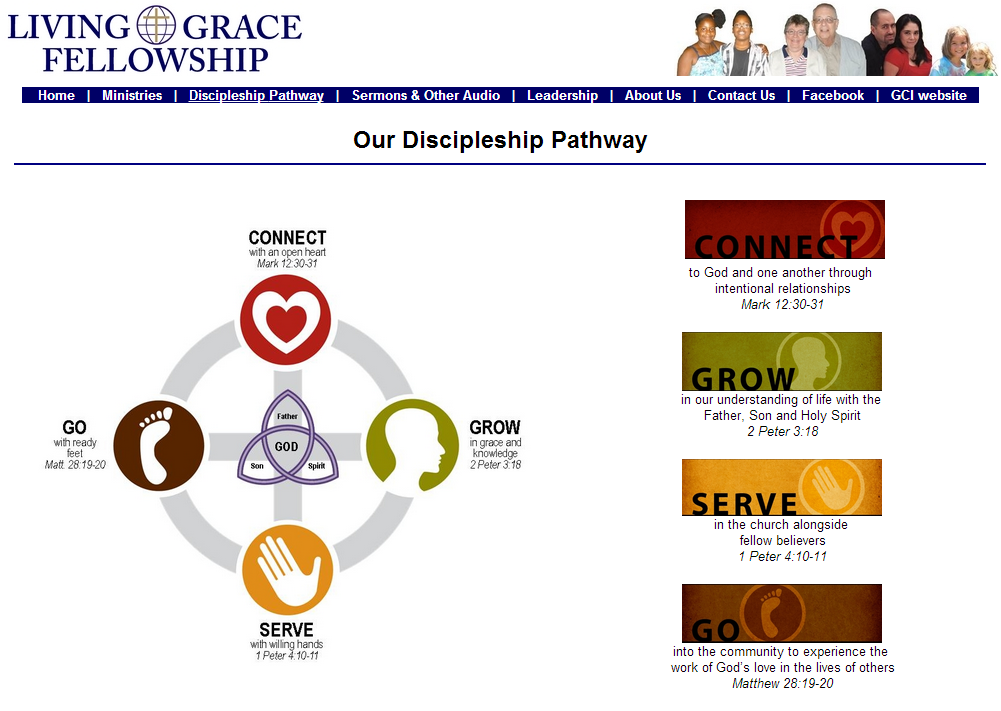Churches and ministries often have more opportunities for ministry than they have time and resources to handle. Thus an appropriate vetting process is needed to decide which opportunities are best. Jim Baker of Sacred Structures offers help in an article titled, “The Ten Most Important Criteria for Vetting New Ministries.” Read it online at http://sacredstructures.org/methods/vetting/.
Category: Church Development
Ministry coaching
Through Church Administration and Development (CAD), GCI-USA trains and certifies ministry coaches and offers coaching to its pastoral leaders including church planters and pastors of established churches. For information about GCI’s coaching services, go to www.gci.org/coaching, and watch this video from CAD ministry coaching coordinator, Anthony Mullins:
On YouTube at http://youtu.be/BzURzDBr2TU.
Hindrances to evangelism
LifeWay president Thom Rainer wrote recently about seven obstacles that hinder many churches from sharing in what Jesus is doing through the Spirit to evangelize non-believers. You can read Thom’s post in his blog at http://thomrainer.com/2014/06/28/seven-factors-hindering-evangelism-churches/.
On a similar note, Greg Williams, associate director of GCI Church Administration and Development, writes about evangelism in the July issue of Equipper. You’ll find it (and all back issues of Equipper) at http://www.gci.org/equipper. U.S. senior pastors are automatically emailed Equipper each month. It’s also emailed to a distribution list. If you’d like to be added to the list, email your request to Ted.Johnston@gci.org.
Lead better by communicating better
 In a recent post at pastors.com, Rick Warren writes helpfully about the need for pastors (as well as all other leaders) to work on their communication skills. As he notes,
In a recent post at pastors.com, Rick Warren writes helpfully about the need for pastors (as well as all other leaders) to work on their communication skills. As he notes,
You can’t lead a church, evangelize a community, or do business without communicating. And the better you become as a communicator, the better you become as a leader, and the better the team you lead becomes as a result. That means to get ahead you’ve got to continually work on your communication skills. Probably 75% of the problems we face, at home, at work, and at church are related to poor communication with family members, church members, your clients, or your coworkers.
Click here to read his post, which offers tips about improving our communication as leaders.
Making disciples with Jesus
Living Grace Fellowship, the GCI congregation in Kansas City, Missouri, has been working to refine its organizational structure and programs to align with a clearly defined “discipleship pathway” that has four steps (see the illustration, below): Connect (with an open heart), Grow (in grace and knowledge), Serve (with willing hands) and Go (with ready feet). The congregation has produced resources that unpack their pathway details, including a PowerPoint presentation, sermons and bulletin handouts. You’ll find these resources on their website at http://lgfkc.gcichurches.org/cgsg.htm.
Living Grace Fellowship leaders, including its pastor, Jason Frantz, are being assisted in the process of developing and implementing this pathway through the Transformational Church consulting services that are offered by GCI Church Administration and Development (CAD). For information about these consulting services, see www.gci.org/cad_services#Consulting. For information about a discipleship pathway, go to www.gci.org/strategy. For assistance from a CAD ministry developer, go to www.gci.org/CAD_Services#Scheduling & contacts.
Cross-generational church life
This update is from Anthony Mullins, Generations Ministries national coordinator.
One of the great joys of my life was serving as a youth pastor for nine years in the Atlanta area. It was a privilege to be part of the journey in the lives of the parents and their teens. One important factor to the life and vitality of that ministry was the senior pastor and I seeing eye-to-eye on an important point: The teens aren’t just the future of the church, they are its present reality. With that in mind, we went about including the teens in the weekly worship service. But most importantly, we included them in the ongoing life of the church. We wanted to make sure that they knew they were included and valued.
I note all this by way of a lead-in to the video below. It captures a discussion that GCI pastor Paul David Kurts had with his sons Jimmy and Mikey concerning their involvement in ministry in their church near Hickory, North Carolina. Jimmy and Mikey are both actively involved there and are developing as leaders in the congregation. If you watch closely, you’ll see that they know they are wanted and needed in their congregation.
This video is on YouTube at http://youtu.be/4kqCFjbw3EE
Doctrine of the Holy Spirit
Here is a video of a lecture given by Gary Deddo at the recent GCI international Mission Developers conference held in New Jersey. The lecture is entitled “The Holy Spirit in the Trinity.” You may find it helpful in your preparations for Pentecost, which is celebrated this year on Sunday, June 8.
On YouTube at http://youtu.be/L4kxqTMDJW8
Trinitarian youth ministry
Below is a video in which GCI Generations Ministries national coordinator Anthony Mullins talks with Presbyterian youth pastor Brad Turnage about an approach to youth ministry that is grounded in Trinitarian incarnational theology.
On YouTube at http://youtu.be/Chta4eu1MNA.
Grace Communion Seminary offers a course in Trinitarian Youth Ministry. For information, click here.
A Sign Forever
This article, which was first published in Odyssey Magazine, is found on GCI’s website at www.gci.org/co/1209/signforever.
Signs are important. We could hardly get along without them. We have signs for road safety, for identifying stores, indicating dangers like poison, radiation or high voltage wires, for finding geographic destinations, or merely navigating our way through an airport or sports stadium.
Signs were also important in the ancient world, including the ancient nation of Israel. The God of Israel gave signs to his people and used them for their benefit. One of the most notable was, of course, the rainbow after Noah’s flood. Another was the Sabbath rest on the seventh day of the week. This sign was given to Israel “forever” (Exodus 31:17).
Some have thought the particular sign of the Sabbath rest given to Israel was so important that we are today under the same obligation. After all, some argue, it was given “forever.” So why shouldn’t this old covenant instruction hold for today?
The important thing to recognize here is that what is eternal is called a “sign.” Christian pastors and teachers down through history have given great consideration to signs, as we find them referred to in both the Old and New Testaments. It is widely recognized and important to understand thatthe purpose of a sign is to point to something else, something greater than itself. For example, when no cat is in sight, the word “cat” spoken or written refers our minds to a particular kind of animal. We think of it, even though it’s not there in front of us. Much of our ordinary language involves the use of signs to point to something that exists but might not be currently available for viewing. It could be said that signs point to what they signify, to the things themselves.
We find in the Bible that the signs God first gave to Israel all pointed to something greater to come, often to God’s invisible character or to his future actions. So the word of the Lord comes to Israel: “I will be your God and you shall be my people.” “I am the Lord your God who took you out of Egypt” (Leviticus 26:12; Exodus 20:2).
Many theologians down through the ages have recognized a pattern. The signs God gives are often promises. And what is promised is the thing signified. Israel was given the promise of a land. The promise wasn’t the land, but it pointed forward to and anticipated its fulfillment, when Israel would enter the Promised Land. The sign was the promise; entering the land was the fulfillment. Furthermore Christian teachers have recognized again and again that the signs given in the Old Testament (or under the old covenant) were fulfilled in Jesus Christ. In fact, Jesus himself was the fulfillment of the sign of the promised Messiah, the fulfillment of God’s promise of deliverance, of salvation.
Now how does this apply to the eternal sign of the Sabbath? Jesus himself helps us answer. Some of the religious teachers of Judaism in his day accused Jesus of violating the Sabbath. How did Jesus reply? Does he say to them, “Well, you have your interpretation of this sign, and I have mine. The people will have to choose between our two interpretations as best they can.” No, that is not what he said. Rather, he pointed out that he is Lord of the Sabbath (Mark 2:28; Matthew 12:8; Luke 6:5). He created the Sabbath. He was there to show them what the Sabbath was really all about. He is the source of our Sabbath rest. In fact, it turns out that Jesus himself fulfills the promise of Sabbath rest (Hebrews 4:1-11). He is our Sabbath rest as we are joined to our Eternal Great High Priest. The sign of the Sabbath pointed to its fulfillment in Jesus. He is the “thing” signified.
The entire Gospel of John is dedicated to help us see the radical difference between the signs God gave and the reality they point to, namely Jesus himself. John the Baptist is the sign, not the promised one himself. So he must “decrease” and Jesus must “increase” in significance. Jesus does not just tell us the truth, show us the way or give us life. Rather, he is the Way, the Truth and the Life. He is the light of the world, he is the bread of life, he is the water of life, he is the resurrection. He is “I am.” All the signs given by God were meant to lead us to the Son of God incarnate. He is, in his own person, the fulfillment of God’s promises. Jesus is both the Giver and the Gift.
We have already mentioned that the purpose of a sign in the working of God is to point us to the reality. Think of road signs pointing out the direction to a big city—say Chicago. Some of them are far away and pointing southward. Some are closer and pointing eastward. There’s no limit to the number and position of signs directing you. But if accurate and clear, each one gives direction for locating the city of Chicago. No one confuses the signs with the reality, the city itself. But that does not make them of no importance. If you’ve never been to Chicago and don’t know the way, accurate signs are helpful—for finding the destination, not loitering around the signposts.
Now think what happens when you reach the actual city, and perhaps even “city center.” You’re glad for the signs and that they were accurate enough to get you to the city. But once you’re there, say at Millennium Park in Chicago, they are no longer important. The city itself, with its skyscrapers, parks, museums and lakefront, far exceeds anything those signs could possibly indicate about its true grandeur. And consider, of what further use are those signs? Not much, if any at all. Their job was to get you to the city. Once there, they have no further use—even though you remain grateful for them.
Now imagine someone standing smack-dab in city center and demanding that you show him a sign that pointed the way to Chicago. If he didn’t recognize that he was already in the city, would the sign help? Or suppose he protested that he could not possibly be in Chicago, since he saw no signs on the way that were anything like what surrounded him now. Thinking the city would be much the same as the signs pointing the way, Chicago should be like a huge flat panel, perhaps with huge, fancy letters, and lights illuminating them, spelling out in glorious brilliance the name “CHICAGO.” If that was what he was looking for, how would you answer? Might you be just a little exasperated?
If you actually produced something like he expected, pointing in some direction, would it be of any use? In fact, if he followed the direction of the arrow on even an impressive and imposing sign you produced for him, where would it take him? Toward Chicago? No. When you have arrived at the city center, an arrow pointing in any direction would lead you away from and eventually out of the city. That sign would actually be misleading! But those other signs still standing outside the city would be of useful service once again. They remain permanently helpful to those who have not yet arrived at City Hall. But they have relatively little meaning once you’ve reached your destination.
The theological signs of the Bible, whether to ancient Israel or those recorded in the New Testament regarding Jesus and the early church, function much like this. The signs pointed to the reality, where the promises God made were fulfilled in person. Those signs stand as permanent, even eternal, pointers to the reality. But once you’ve followed their lead and have met the reality—Jesus himself—they have fulfilled their purpose and are no longer needed. They are superseded by the reality. You could never confuse the sign with the far greater reality of what they pointed to. Perhaps this is why, when asked, Jesus sometimes refused to give another sign. He told them they already had plenty of signs. No sign will help them recognize the reality when it’s standing there in front of them face to face.
So when we read that God has given us certain signs forever, this is true. They eternally point to the promised reality. But when you’ve met the Lord of All Signs, all others, having done their work, can now only have relative value—value relative to the Reality of their Lord.
Photo Credits: 123RF
20 questions for preachers
 Preaching is a craft that, like any other, needs careful honing. In an article posted at ChurchLeaders.com, preacher Bob Hostetler wrote this:
Preaching is a craft that, like any other, needs careful honing. In an article posted at ChurchLeaders.com, preacher Bob Hostetler wrote this:
Years ago, when I first began preaching, I developed a list of 20 questions to evaluate a sermon—before preaching it. It remains a mental checklist…that I try to apply to my own speaking.
To read the full post, including the list of his 20 questions, click here.





